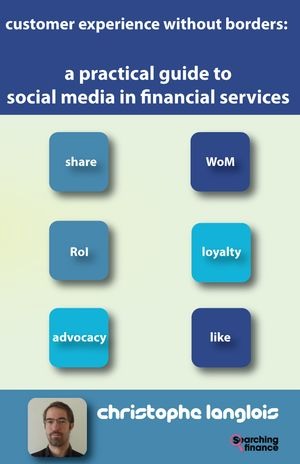
He's doing a good job working with risk-averse financial institutions who, in the main have shifted from 'should we do social media?' to 'when and how should we start?'. He's done this, in part, by turning some of the banks' own jargon back on them. In particular, Christophe's coining of the 'KYF' acronym... Know Your Fans, Friends or Followers... is derived from the now well-established regulatory principle 'KYC' - Know Your Customer.
By hiding-in-plain-sight in this way, Christophe has been able to work with execs and their teams across the industry and encourage them to start asking the right questions about social media, their businesses and their customers, as well as advising them as to how to avoid early pitfalls.
Christophe expressed reservations about Social CRM, (often seen as a great emerging SI opportunity for suppliers hoping to stitch established CRM platforms together with newer Social Media monitoring platforms!). In short, bundling in masses of unstructured and unverified social media content to already burgeoning silos of often unwieldy customer data is the last thing the banks need right now. There may be some exceptions for the new-to-market.
Later in the conversation Christophe said that analysis of followers and friends could, however, be worth a potentially speculative investment in bolstering data held around a bank's social media activities...
Who are a bank's followers?
Customers? Definitely!
Competitors? Probably!
Journalists? Undoubtedly!
So, being able to, where possible, categorise these followers into meaningful groups, lists or even circles could serve to inform and enhance a social media engagement strategy.
The thorny issue of the Tournier Principles cropped up at this point - these are the legal principles which concern themselves with the circumstances under which banks should and should not disclose information about customers.
Naturally, banks are pretty nervous about acknowledging or otherwise commenting on a customer relationship on an open social network, but here Christophe was able to lend a hand, by making a distinction between customers and followers and treating them slightly differently. Followers may well benefit from directed tweets, articles, events, offers etc based on their location or other aspects of their public profile, without the bank needing to delve into a possible customer relationship.
Indeed this kind of engagement may serve to reinforce established customer relationships or encourage new ones, but won't directly augment those relationships, unless the bank has a strategy to direct conversations from an open network to a more secure environment/channel which might include forums, secure email, contact centres or even branches.
Christophe, in closing, dispelled another myth which is causing unnecessary anguish amongst banks nervous about stepping into social media, and that is how to deal with a potential tsunami of customer service queries and other demands the instant a bank announces a presence on Twitter or Facebook.
The reality is, even the very biggest names in banking find this manageable and are able to establish great engagement practices through a relatively slow and steady (albeit growing) number of customer contacts coming in each day in this way.
An army of social media agents is not required. A small number of passionate advisors willing to learn, engage and adapt their established customer-facing skills is all that is needed to start.
There's much more of this in Christophe's book (sadly not on Kindle) (Update: Christophe tells me there's a Kindle version on the way) and at his site.
It's worth a look.